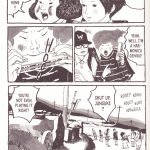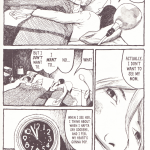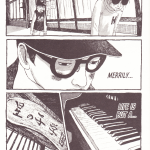Taiyo Matsumoto has a penchant for writing stories about children. He examines the world through a child’s eyes, a child’s hopes and dreams, and most importantly a child’s questions. Questions are how Matsumoto starts his latest English release, Sunny, published under Viz’s Sig IKKI line. Not with panoramas or images of far-fetched monsters like his earlier works, Tekkonkinkreet and GoGo Monster, but with questions. The difference sets the tone for a series that looks at Matsumoto’s own childhood.
Sunny is about a group of kids living at the Star Children’s Home. Each chapter of the comic asks a new question and each chapter is a moment in the lives of these children seen through a different character’s eyes. The connecting point is the Star Children’s Home, a sort of foster agency/orphanage and an old rusted out Datsun Sunny that the children nap, play, and dream in. For some, the Sunny is a place to escape, driving on the moon or playing outlaw like the brash, white-haired Harou. For others, it is a place to remember, driving back home to the family that abandoned you, like newcomer Sei.
Part of what makes Sunny so riveting is its true-to-life styling. Author Matsumoto is writing from experience as a child growing up in an orphanage. Whatever it is, Sunny feels like a combination confessional, re-imagining, and autobiography. Matsumoto uses this part of his life to explore the worries of children and the way they deal with them. The angers and quarrels of children are all there, with hogging toys and worrying about four-leaf clovers. The underlying questions about why the children are at the home, where their parents are, why some children look forward to visitation days and others dread them all dwell underneath the play and the boisterous energy. The combination of these questions and the children’s circumstances lends Sunny a melancholy that is pervasive.
Matsumoto’s sketchy artwork is complemented by earth tones and the coloring work of his wife, Saho Tono. The mix of sketchiness and painterly aesthetic makes the whole book a joy to look at. The art conveys just the right amount of detail and energy, while still maintaining a reminiscent quality. The use of watercolor with Matsumoto’s usual art and powerful lines bring a depth to Sunny that shows that despite his proven strength as a cartoonist, Matsumoto continues to grow and evolve.
Sunny is Matsumoto writing from a place we haven’t seen before despite using similar themes. While I’ve really enjoyed his previous work, none of it has resonated as well for me as Sunny has. Sunny is an expressive, beautiful, thought-provoking comic that deserves your attention. Recommended.




